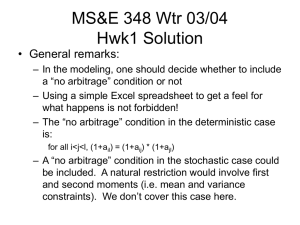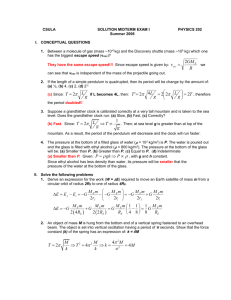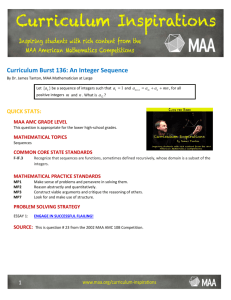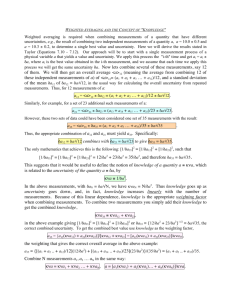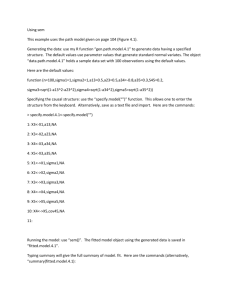SINGULAR KLEIN MANIFOLDS
advertisement
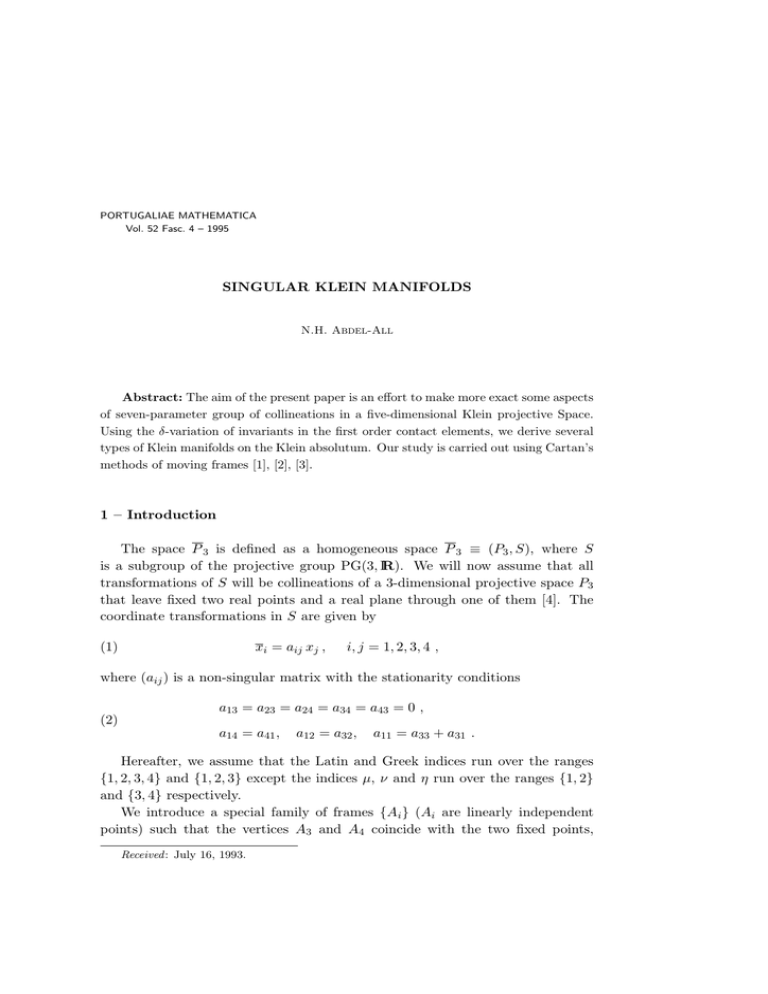
PORTUGALIAE MATHEMATICA
Vol. 52 Fasc. 4 – 1995
SINGULAR KLEIN MANIFOLDS
N.H. Abdel-All
Abstract: The aim of the present paper is an effort to make more exact some aspects
of seven-parameter group of collineations in a five-dimensional Klein projective Space.
Using the δ-variation of invariants in the first order contact elements, we derive several
types of Klein manifolds on the Klein absolutum. Our study is carried out using Cartan’s
methods of moving frames [1], [2], [3].
1 – Introduction
The space P 3 is defined as a homogeneous space P 3 ≡ (P3 , S), where S
is a subgroup of the projective group PG(3, IR). We will now assume that all
transformations of S will be collineations of a 3-dimensional projective space P 3
that leave fixed two real points and a real plane through one of them [4]. The
coordinate transformations in S are given by
xi = aij xj ,
(1)
i, j = 1, 2, 3, 4 ,
where (aij ) is a non-singular matrix with the stationarity conditions
(2)
a13 = a23 = a24 = a34 = a43 = 0 ,
a14 = a41 ,
a12 = a32 ,
a11 = a33 + a31 .
Hereafter, we assume that the Latin and Greek indices run over the ranges
{1, 2, 3, 4} and {1, 2, 3} except the indices µ, ν and η run over the ranges {1, 2}
and {3, 4} respectively.
We introduce a special family of frames {Ai } (Ai are linearly independent
points) such that the vertices A3 and A4 coincide with the two fixed points,
Received : July 16, 1993.
500
N.H. ABDEL-ALL
but the invariant plane is determined by means of the points A2 , A4 , A1 + A3 .
Therefore the fundamental equations of the frames are given by
dAi = ωij Aj .
(3)
The one-forms ωij satisfy the stationarity conditions
(4)
(
ω31 = ω32 = ω34 = ω41 = ω42 = ω43 = 0 ,
ω21 = ω23 ,
ω11 = ω13 + ω33 ,
ω13 + ω22 + 2ω33 + ω44 = 0 .
Thus, we have ωij with the conditions (4) are the invariant one-forms of a sevenparameter group of collineations. The integrability conditions of the invariant
group S are given by
(5)
Dω22 = ω23 ∧ ω12 , Dω13 = −ω23 ∧ ω12 ,
Dω23 = ω23 ∧ (ω13 + ω33 − ω22 ) ,
Dω33 = 0 ,
Dω 2 = −ω 2 ∧ (ω 3 + ω 3 − ω 2 ) ,
1
3
2
1
1
4
4
3
3
Dω1 = −ω1 ∧ (2ω1 + 3ω3 + ω22 ) + ω12 ∧ ω24 ,
4
4
3
3
2
3
4
Dω2 = −ω2 ∧ (ω1 + 2ω3 + 2ω2 ) + ω2 ∧ ω1 .
For a general discussion of Klein-representation (for brevity K-R) of line manifolds on the Klein-quadric (K-absolutum), the reader is referred to [5], [6], [7]. It
is well-known that a line ` ⊂ P 3 is represented by a point `k of a Klein five dimenk
sional projective space P 5 . The locus of `k as the line ` varies is the Grassmann
manifold Gr(1, 3) of all lines in P 3 . The manifold Gr(1, 3) is equivalent to the
K-R of the lines of P 3 by K-points (P ij ) (i < j, P ij = −P ji ) of the K-absolutum
2
k
Q4 ⊂ P 5 .
k
We introduce the K-frames in P 5 as a six-hedron moving K-frame {Aij } in
which Aij are the K-images of the edges (Ai , Aj ) of the frame {Ai } ⊂ P 3 . The
infinitesimal displacements of the K-frame {Aij } are given by
(6)
dAij = ωik Akj + ωjk Aik
up to the stationarity conditions (4).
2 – Characterization of K-absolutum
k
From the displacements (6) with (4), it is easy to see that the space P 5
2
2
contains a degenerate K-absolutum Q4 . The absolutum Q4 consist of two invariant K-planes P 1 ≡ (A13 , A23 , A34 ), P 2 ≡ (A14 , A24 , A34 ), invariant K-point
A34 ≡ P 1 ∩ P 2 and invariant K-line Lk ≡ (A24 , A14 + A34 ) ⊂ P 2 .
SINGULAR KLEIN MANIFOLDS
501
Thus, we have the following:
2
k
Lemma 1. The K-absolutum Q4 ⊂ P 5 consist of two fixed planes P 1 , P 2 ,
fixed point P 1 ∩ P 2 and fixed line Lk ⊂ P 2 .
From (6), (4) and (3), we have Det Ω(dA12 , dA12 ) = 1, trac Ω(dA12 , dA12 ) = 0
where Ω is a quadratic form defined as the following
Ω(Aij , Amn ) =
ij
δmn
=
(
1, i 6= j 6= m 6= n,
0, otherwise .
Thus, we have proved the following:
2
k
Lemma 2. The K-absolutum Q4 ⊂ P 5 is a minimal hyper surface with
Gaussian curvature equal one.
The coordinates of the i-th vertex of the frame {Ai } are δji . Thus the coordii j
ij
i j
nates Aij
mn of the K-R to the line Amn are given by Amn = δm δn − δn δm and so
we have the following:
Lemma 3. Each pair of the K-points Pij , Pmm , whose index pairs contain
at least one common number, satisfy
Ω(Pij , Pmn ) = 0 .
In the case of Lemma 3, the lines Pij , Pmn are called in involution (projectively
orthogonal).
3 – Three-dimensional K-manifolds
We establish the fundamental equations of a 3-dimensional K-manifold (line
2
k
2
k
complex in P 3 ) immersed in Q4 ⊂ P 5 , for brevity M3k ⊂ Q4 ⊂ P 5 . From the
displacement dA12 in (6), it follows that the principal forms on the K-absolutum
2
Q4 are ωµη and from (5) we have Dω23 ≡ 0 (mod ω23 ). Thus, the differential
equation of the K-manifold M3k can be written as the following
(7)
ω23 = Bα θα ,
where (θ α ) = (ω13 , ω14 , ω24 ) are the principal forms on M3k and Bα are real valued
functions on the first order contact element U1 .
502
N.H. ABDEL-ALL
Exterior differentiation of (7) leads to the quadratic exterior equation
(8)
n
o
dB1 + B1 (B1 θ1 + θ2 − θ3 ) − 3B2 θ2 ∧ θ1 +
n
o
+ dB2 + B2 (B1 θ1 + 4θ2 ) + B1 B3 θ1 ∧ θ2 +
n
o
+ dB3 + B3 (θ2 + 3θ3 + θ1 ) + ∆+ θ1 ∧ θ3 = 0 ,
where ∆+ = B2 + B1 B3 .
The variations δBα of the invariants Bα are given by [8]
(9)
δBα = −Mαβ πβ ,
where θ α (δ) = 0, θβ (δ) = πβ , (θβ ) = (ω12 , ω33 , ω22 ) and δ is the differentiation
with respect to the secondary parameters. The matrix (Mαβ ) in (9) is called the
attitude matrix and is defined in terms of the invariants Bα as the following
M11 = B12 ,
(10)
M12 = −M13 = −B1 ,
4M21 = M13 M23 ,
M22 = 0,
M23 = 4B1 ,
M33 = 3B3 = 3M32 ,
4M31 = 4M32 M13 + M23 .
In general the matrix (Mαβ ) has rank h = 3, that is B1 B2 ∆+ 6= 0. From (6)
ad (7), we get
dA12 ≡ θ1 (B1 A13 − A23 ) + θ 2 (B2 A13 − A24 ) + θ 3 (B3 A13 + A14 ) (mod A12 ) .
Using Lemma 3, we have the quadratic form
(11)
Ω(dA12 , dA12 ) ≡ aαβ θα θβ ,
defined on the K-manifold M3k , where a11 = 0, a12 = −B1 , a13 = −1, a22 = −2B2 ,
a23 = −B3 , a33 = 0 and its determinant is ∆− = B2 −B1 B3 . In general (∆− 6= 0)
the rank h0 of the quadratic form (11) is three.
The following definitions are very important in the sequel [5].
Definition 1. The K-manifold M3k for which h < 3 is called singular of rank
3 − h, h ≤ 2.
Definition 2. The K-manifold M3k for which h0 < 3 is called special of order
3 − h0 , h0 ≤ 2.
h0
From (11), one can see that h0 can not be equal to zero or one and hence
= 2 in the case where ∆− = 0. Thus, we have
SINGULAR KLEIN MANIFOLDS
503
Lemma 4. The K-manifold M3k characterized by ∆− = 0 is of type special
of order one.
The definitions (1) and (2) lead to the following
Lemma 5. Singular K-manifolds M3k of rank one and non-special are divided
into three subclasses given by
ω23 = B2 θ2 + B3 θ3 ,
(Type T1 )
ω23
(Type T2 )
= B1
θ1
+ B3
θ3 ,
ω23 = B1 θ1 − B1 B3 θ2 + B3 θ3 , (Type T3 )
Lemma 6. Singular K-manifolds M3k of rank two and special of order one
are given by the following ω23 = B3 θ3 . We denote its type by T4 .
Lemma 7. Singular K-manifolds M3k of rank three and special of order one
are given by the holonomic equation ω23 = 0.
In each of the above types, the existence theorem can be proved using Cartan’s
common methods. Thus, we have:
Theorem 1. The range of existence of the K-manifolds of types Tα (T4 )
comprises one arbitrary function of two arguments (one argument).
For the general K-manifold (7), we may specialize the frames such that
θα = Cαβ θβ .
(12)
Using Cartan’s lemma in (8), we have
(13)
dBα + Mαβ θβ = Eαβ θβ ,
where Eαβ are invariants defined in the 2nd order contact element U2 ⊂ U1 on
the K-manifold M3k . The invariants Eαβ satisfy the integrability conditions
(14)
E12 = E21 + 2B2 + ∆+ ,
E23 = E32 ,
From (12), (13) and (14), we get
(15)
dBα = bαβ θβ ,
E13 = E31 + B3 .
504
N.H. ABDEL-ALL
where
b1α = E1α − B1 (B1 C1α − C2α + C3α ) + 3B2 (α − 1) (3 − α) ,
b2α = E2α − B2 (B1 C1α + 4C3α ) − B1 B3 (2 − α) (3 − α)/2 ,
³
´
b3α = E3α − ∆+ C1α + B3 (C2α + 3C3α + (2 − α) (3 − α)/2) .
The Gauss equation is given by
(16)
d2 A12 ≡ b2αβ θα θβ A13 − aαβ θα θβ A34 .
The quantities b2αβ are the components of covariant quadratic symmetric tensor
defined in terms of the quadratic tensors aαβ , Eαβ , Cαβ as the following:
b211 = E11 + B3 − B1 (1 + C31 − C21 ) ,
b222 = E22 + B2 (B3 − 4C32 ) ,
b233 = E33 − B3 (C23 + 3C33 ) ,
b212 = 2E12 + B1 (2B3 − C32 + C22 ) − 4B2 (1 + C31 ) ,
b213 = 2E13 − B3 (2 + C21 + 3C31 ) − B1 (C33 − C23 ) ,
b223 = 2E23 + B3 (B3 − C22 − 3C32 ) − 4B2 C33 .
The Wiengarten equations are
³
´
dA34 = − θ1 + (C3α + C2α ) θα A34 ,
dA13 = (θ 1 + 2C3α θα ) A13 − θ2 A34 + C1α θα A23 .
In our present investigation we are again concerned with the K-manifold M 3k
given by (7) and we continue to require that h = 3, h0 = 3.
4 – Two-dimensional K-manifold
If there exists a relation between the forms θ α on M3k , we have a 2-dimensional
K-manifold. Without loss of generality, if we take
(17)
ω24 = Eµ ψ µ ,
where (ψ µ ) = (θ η ), such that the equation (7) for (17) represents a two-dimensional
K-manifold (line congruence in P 3 ) immersed in the K-manifold M3k and we deck . This immersion is given by [9], [10]
note it by M
2
(18)
ω24 = Eµ ψ µ ,
bµ ψ µ ,
ω23 = E
SINGULAR KLEIN MANIFOLDS
505
bµ = Bµ + B3 Eµ and Eµ are functions defined in the 1st order contact
where E
b1 of the K-point A12 on
element U
2
ck ⊂ M k ⊂ Q .
M
2
3
4
Exterior differentiation of (18) and using Cartan’s lemma, there exist the real
biµ : U
b2 ⊂ U
b1 → IR such that
valued functions E
(19)
ciα θα = E
biµ ψ µ ,
dEi + M
bµ ) and the invariants E
biµ satisfy the integrability conditions
where (Eη ) = (E
b12 − E
b21 = 3E
b2 ,
E
b1 + M
c21 .
E32 − E41 = E2 − E
ciα are defined in terms of Eµ , E
bµ as the following:
The invariants M
c11 = E1 (E2 + E
b1 ) ,
M
c21 = E1 E
b2 + E 2 ,
M
2
c31 = E1 E
b2 − E
b2 ,
M
1
c41 = E
b2 (E2 + E
b1 ) ,
M
c12 = M
c13 = −2E1 ,
M
c22 = −M
c23 = −E2 ,
M
c32 = −M
c33 = −E
b1 ,
M
c42 = 0 ,
M
c43 = −4E
b2 .
M
ck are given by
Using (12), the forms θα on the K-manifold M
2
θα = Cbαµ ψ µ ,
Cbαµ = Cαµ + Cα3 Eµ .
The Gauss and Wiengarten equations of the immersion (18) are given as the
following
(20)
dA12 ≡ ψ µ eµ (mod A12 ) ,
d2 A12 ≡ φ14 A14 + φ13 A13 + φ34 A34 (mod A12 , dA12 ) ,
bµ A13 − Nµ , N1 = A23 , N2 = A24 , φ14 = F 1 ψ µ ψ ν ,
where eµ = Eµ A14 + E
µν
2 ψ µ ψ ν , φ34 ≡ a
ck .
bµν ψ µ ψ ν ≡ Ω(dA12 , dA12 ), A12 ∈ M
φ13 = Fµν
2
506
N.H. ABDEL-ALL
µ , a
bµν are symmetric in the indices µ, ν and are given by
The invariants Fµν
1
b31 + 2E1 ζ1 ,
F11
=E
1
b42 − E
b2 + E2 ζ−1 ,
F22
=E
1
b32 + 1 E2 (1 + ζ−1 ) + E1 ζ1 − E
b1 ,
F12
=E
2
2
b11 − 1 + E
b1 ζ−1 ,
F11
=E
2
b22 − eE
b2 (C32 + C33 E2 ) ,
F22
=E
³
´
2
b2 3 − 4(C31 + C33 E1 ) + 1 E
b1 ζ−1 ,
b12 + 1 E
F12
=E
2
2
b11 = −2E1 ,
a
b 1 + E2 ) ,
b12 = −(E
a
b2 ,
b22 = −2E
a
ξε = C22 + ε C32 + (C32 + ε C33 ) E2
and
ζε = C21 + ε C31 + (C23 + ε C33 ) E1 ,
ε = ±1 .
c of the
In [6], a computational technique for the Gaussian curvatures K and K
k
k
c is given. Thus, we have
K-manifold M3 and the immersion M
2
K = Det(b2αβ )/∆− ,
(21)
´
³
c = Det(F 1 ) + Det(F 2 ) / Det(a
bµν ) ,
K
µν
µν
respectively .
5 – CK-curves
On the K-manifold M3k , if there exist two independent relations between the
forms θ α as the following
(22)
θ µ = φµ θ 3 ,
ω23 = φ3 θ3 ,
φ3 = B µ φµ + B 3 .
The system (22) represent a K-curve (ruled surface in P 3 ) immersed in the
K-manifold M3k or for brevity, a CK-curve.
Exterior differentiation of (22) and using Cartan’s lemma, we get
fαβ θβ + F α θ 3 ,
dφα = Σ M
(23)
fαβ are the elements of an attitude matrix attached to the CK-curve (22)
where M
and are given by
f11 = −3M
f32 = −M
f33 = 3 φ3 ,
3M
f21 = 1 ,
M
f22 = −M
f23 = −φ2 ,
M
f12 = M
f13 = −2 φ1 ,
M
f31 = 0 .
M
507
SINGULAR KLEIN MANIFOLDS
The functions φα , F α are invariants in the 1st, 2nd order contact elements
e1 , U
e 2 (U
e2 ⊂ U
e1 ) of the K-point A12 on the CK-curve (22) respectively.
U
The δ-variations of the invariants φα (F α (δ) = 0) are given by
fαβ πβ .
δ φα = Σ M
(24)
fαβ ) has rank three. The curves (22) are
For a general CK-curve, the matrix (M
singular of rank one and two if the following conditions
(I1 )
φ3 = 0, φ1 6= 0 ,
(I2 )
φ3 = 0 φ 1 = 0 ,
Bµ φµ = −B3 ,
φ2 = −(B3 /B2 ), B2 6= 0 ,
are satisfied respectively.
We denote the classes of CK-curves according to the conditions Iµ by Cµ
respectively.
In the following, we consider differential projective invariants of all orders on
the Cµ curves.
For this purpose, we derive the projective Frenet–Serret formulae and the
differential equations of the classes Cµ of CK-curves.
The class C1 is characterized by the differential equations
(25)
θ1 = 0 ,
ω23 = 0 ,
Dθ3 ≡ 0 (mod θ 3 ) ,
θ 2 = φ2 θ 3 ,
B2 φ2 + φ 3 = 0 .
The motion along a CK-curve of the class C1 is given by
dA12 ≡ −θ 3 (φ2 A24 + A14 )
d2 A12 ≡ F 2 (θ3 )2 A24
d3 A12 ≡ 0
(mod A12 ) ,
(mod A12 , dA12 ) ,
(mod A12 , dA12 , d2 A12 ) .
Thus, the CK-curves of the class C1 are plane curves in the K-plane
(A12 , A14 , A24 ) with projective curvature equal to the invariant F 2 . Thus, we
have proved the following
Theorem 2. The CK-curves of the class C1 are plane CK-curves (developable
ruled surfaces of a line complex in P 3 ) with curvature equal to the invariant F 2 .
The CK-curves of the class C2 are characterized by the system of differential
equations
(26)
θ µ = φµ θ3 , ω23 = 0, Bµ φµ = −B3 , Dθ3 ≡ 0
(mod θ 3 ) .
508
N.H. ABDEL-ALL
From (26) and (12) we get
θα = (Cαµ φµ + Cα3 ) θ3 .
(27)
Putting Fb µ = F µ /(2φ1 ), d/dθ 3 ≡ D, hε = (C3µ + εC2µ ) φµ + C33 + ε C23 , ε = ±1.
From (3), (6), (7), (26) and (27) we get
(28)
D r A12 ≡ Ωr Qr (mod A12 , Q1 , Q2 , ..., Qr−1 )
(r = 1, 2, ..., 5) ,
where Q1 = φµ Nµ − A14 , Q2 = A34 − Fb µ Nµ ,
Q3 = A24 + f A23 ,
Q5 = Q2 + Fb µ Nµ
Q4 = N 1 ,
and
³
´
f = F 1 (D log |Fb 1 | + 2 h1 − Fb 1 ) /Ω3 .
The invariants Ωr are given by the relations
Ω1 = −1 ,
Ω2 = −2 φ1 ,
³
(29)
´
Ω3 = F 2 D log |Fb 2 | − Fb 1 + h−1 ,
4
Ω =Ω
3
µ
³
Df + f (C31 + 3C21 ) φ1 + (C32 + 3C22 ) φ2
+ C33 + 3C23
Ω5 = −Ω4 .
´
+ (f Fb 2 − Fb 1 )
¶
,
The invariants Ωi (i 6= 1) are called the projective curvatures of CK-curves
(non developable ruled surfaces in P 3 ) of the class C2 . Thus, we have proved the
following
Theorem 3. The infinitesimal displacements of the Frenet–Serret frame
{A12 , Qr } are given by (28) and the projective curvatures are given by (29).
REFERENCES
[1] Wladyslow, S. – Exterior forms and their applications, Warsaw, 1970.
[2] Svec, A. – Global differential geometry of surfaces, D. Reidel, Publishing company,
1978.
[3] Abdel-All, N.H. – Classification of line manifolds in an Appell 3-space, Tensor,
N.S., 50(1) (1991), 74–78.
SINGULAR KLEIN MANIFOLDS
509
[4] Petrova, P. and Mekerov, D. – Curves in a 3-dimensional projective space
with an absolute of two real points and a real plane through one of them, Plovdiv.
Univ. Naucn. Trud., 13(1) (1975), 239–249 (1977).
[5] Hlavaty, V. – Differential line geometry, Groningen Nordhoff, 1953.
[6] Abdel-All, N.H. – Klein correspondences of a class of line complexes in elliptic
spaces, Tensor, N.S., 48(2) (1989), 110–115.
[7] Abdel-All, N.H. – Quasi-hyperbolic manifolds, Tensor N.S., 51(3) (1992),
224–228.
[8] Abdel-All, N.H. – A geometrical interpretation of fundamental differential invariants of line manifolds in Galilean space, Tensor, N.S., 48(2) (1989), 114–119.
[9] Mekerov, D. and Kozuharova, R. – Congruences of lines in a 3-dimensional
projective space with a plane absolute and a sequence of points on it, Plovdiv. Univ.
Naucn. Trud., 13(1) (1975), 251–271 (1977).
[10] Mekerov, D. and Kozuharova, R. – On the differential geometry of congruences of lines in the space A(9), Plovdiv. Univ. Naucn. Trud., 13(1) (1975),
273–287 (1977).
N.H. Abdel-All,
Maths. Dept., Faculty of Science,
Assiut University, Assiut – EGYPT
